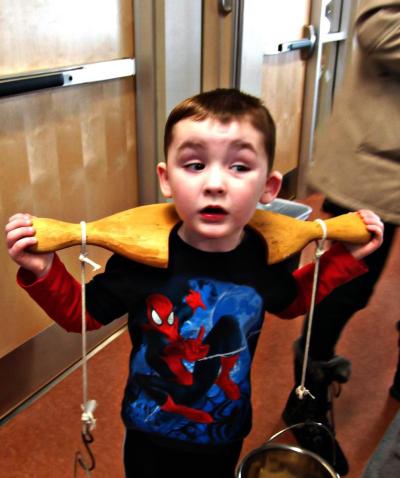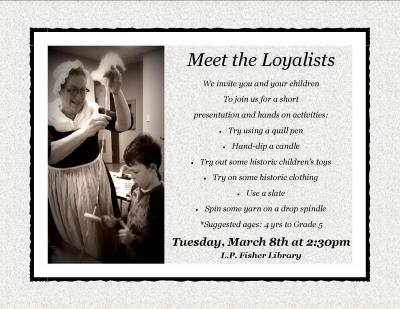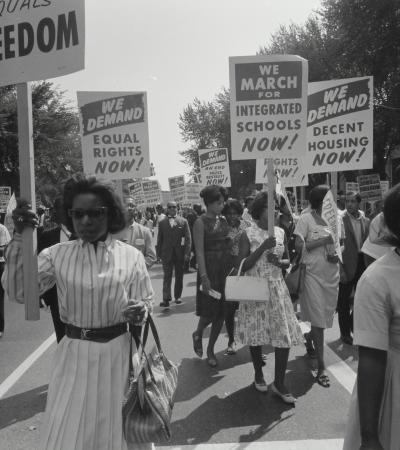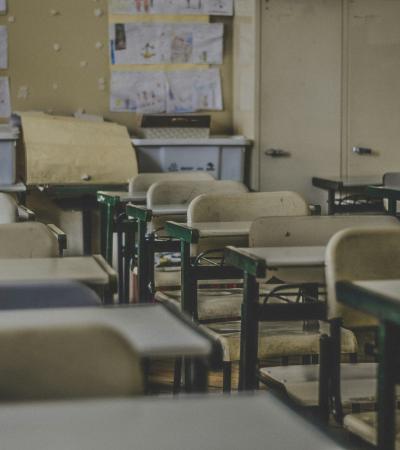When we hear the words "kinesthetic" or "physical" linked with literacy, we often think of sports, gym class, dance, yoga and other gross-motor-type programs. What we often overlook is how we are already incorporating much physical literacy in our library programs by adding tactile, hands-on activities to storytimes or events. And this is awesome — not only are we appealing to tactile learners (those than learn best by doing, not just seeing or hearing) but we are enhacing everyone's literacy skills, even the parents!

This month I wanted to celebrate one of my staff members, Kate Waller, who excels in including fine and gross motor skills in her storytimes and programming. We have a good-sized homeschooling community here in small-town Woodstock, N.B., and Kate created a wonderful Loyalist Program to teach them about one aspect of our region's history, which she's been refining over the last 10 years. We offered it in March, and it was so popular (we had 45 people attend!) that we offered another one to the public. We had 69 people show up to the second program, and now Kate is doing outreach by bringing the program to local schools.
I'm so proud! As someone who specializes in physical literacy, I was fascinated to watch the kids (including my own) and their parents using their hands to learn so many new skills, such as making candles and spinning yarn, as well as using all their senses to really get a feel for the history that Kate is so passionate about. Their eyes lit up with wonder as they rubbed their hands through the sheep's fleece and touched Kate's amazing collection of antiques. Here's a descripton from Kate, in her own words, on what makes the program so special:
Meet the Loyalist is a family-friendly program I designed that stemmed out of a desire to get children excited about a piece of our local history, a wish to bring my experience as an 18th-century reenactor to the library, and a desire to encourage children to explore with all of their senses and learn kinaesthetically. The program begins with me playing the part of a Loyalist refugee, speaking of my ordeal in a first-person interpretation. I have the children close their eyes and use their imaginations as I describe of having to leave my home and travel to Canada by ship and the experiences of our first winter.

I get the them to open their eyes, show them some of the 18th-century replica items, and encourage children to touch these handmade household objects that the Loyalists would have been able to make from locally available materials, such as horn spoons, flax, a wooden comb and woven woolen material. I speak about the work that we had to learn to do to survive and demonstrate a few skills (e.g., spinning with a drop spindle). Then the children divide into stations in order to experience many of the skills and crafts that men, woman and children would have been required to do in the 18th century. The children are given free choice of many different activities to try. The participants use both small and large motor skills to spin with drop spindle, dip candles, embroider, write with a quill pen and ink, make a clothespin doll, try on period clothing, balance a yoke and bucket, write on a slate with chalk, learn to tie ships’ knots and card fleece. Other activities that have been included in past programs have been butter churning, washing clothing on a washboard and basin, and cooking a simple period recipe.
The children also got the opportunity to try out historic children's games and toys, which gave them real insight into the way children's lives used to be both different and similar to their own. While books and movies are a wonderful way to learn about history, there is nothing quite as memorable as getting to participate in a little bit of history yourself.



